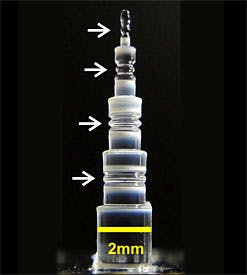NIST makes optical frequency-comb setup in two minutes
Boulder, CO--Laser frequency combs, which, as Laser Focus World readers know, are used in advanced atomic clocks (and are also used in medical diagnostics and astronomy), are not only getting smaller but also much easier to make. Researchers at the National Institute of Standards and Technology (NIST) now say they can make the core of a miniature frequency comb in one minute. Conventional microfabrication techniques, by contrast, can take hours, days, or weeks.
The NIST technique involves laser machining of a quartz rod to shape and polish a small disk resonator. The user controls the size and shape of the resonator and can create diameters from about 0.2 to 8 mm; its thickness and curvature can be shaped as well. The quality factor (Q) of at least 5 × 108 equals or exceeds that of cavities made by other methods.
After machining the quartz, NIST scientists use a small, low-power infrared laser to create the comb. A primary benefit of the high Q factor is that only a few milliwatts of laser light are required to generate a comb.
"We make a resonator in one minute, and one minute after that we are making a frequency comb," NIST researcher Scott Papp says. The system for the NIST process costs only about $10,000, most of that for purchase of a carbon dioxide laser used for cutting.
A typical NIST microcomb produced by such a resonator might have 300 "teeth," or ticks on the ruler. The individual teeth can be stabilized relative to each other to <0.5 mHz.
A key advantage of microcombs is the ability to tune the frequency spacing between the teeth, as needed, for applications such as calibrating astronomical instruments. The spacing is determined by the size of the cavity; a smaller cavity results in wider spacing between the comb teeth.
Scientists plan to apply for a patent on the machining technique, which could be applied to a variety of other glassy materials. Future NIST research will focus on continuing improvements in comb performance and use of the resonators in other compact applications such as optical frequency standards and low-noise microwave oscillators.

John Wallace | Senior Technical Editor (1998-2022)
John Wallace was with Laser Focus World for nearly 25 years, retiring in late June 2022. He obtained a bachelor's degree in mechanical engineering and physics at Rutgers University and a master's in optical engineering at the University of Rochester. Before becoming an editor, John worked as an engineer at RCA, Exxon, Eastman Kodak, and GCA Corporation.
